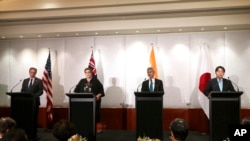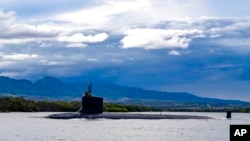washington —
A major initiative to strengthen and cement America’s ties with Asia and counterbalance China's expanding influence lacks robust trade incentives that are viewed as politically perilous in the United States, where protectionist sentiment runs high, experts told VOA.
The United States needs to intensify its focus on the Indo-Pacific region because of the “mounting challenges” posed by the rise of China, according to a strategy document released by the Biden administration last week.
“The PRC [People's Republic of China] is combining its economic, diplomatic, military and technological might as it pursues a sphere of influence in the Indo-Pacific and seeks to become the world’s most influential power,” the strategy document said.
That description of China largely mirrors the view taken by the former Trump administration, which often took a bluntly adversarial stance toward Beijing. Beyond rhetoric, however, Biden’s strategy seeks to shore up regional alliances and partnerships that many see as critical to U.S. strategy in Asia.
It responds to the desire of many countries in the region for the United States to play a galvanizing role in addressing common challenges such as public health, climate change and anti-corruption, Ryan Hass, senior fellow at the Brookings Institution, told VOA.
“It is a welcome departure from the America-first mindset during the Trump era,” Hass said.
No economic framework, leadership
The new strategy calls for advancing freedom and openness, building collective defense capacity within and beyond the region, and building regional resilience. It also embraces what the administration calls “promoting shared prosperity.”
But Hass and other observers say the Indo-Pacific strategy lacks a coherent trade framework that gives countries in the region a good economic reason to deepen relations with the U.S. They say Washington’s international economic agenda should match the leadership role the United States seeks for itself in the region.
Robert Daly, director of the Wilson Center's Kissinger Institute on China and the United States, told VOA the strategy suffers from a fundamental contradiction in that it implies that the U.S. will engage in a high degree of global activism, following years of far more isolationist foreign policy under the Trump administration. At the same time, the Biden administration has not primed the American public to shift away from the Trumpian critique of globalization.
“They've put themselves in a box where they, for political reasons, seem to accept the Trump view that globalization is the playground of self-indulgent coastal American elites who don't care about the heartland [of America],” Daly said. “What was needed was a better form of globalization that serves American interests — the Biden administration has chosen not to take that on.
Preceding Trump, the former Obama administration championed the Trans-Pacific Partnership, a massive trade agreement with 11 other countries designed to be the cornerstone of U.S. economic policy in the region. The Trump administration withdrew from the TPP in 2017, leaving the other members to sign a revised deal, called Comprehensive and Progressive Agreement for Trans-Pacific Partnership (CPTPP).
With no public support for multilateral trade agreements, the Biden administration has said it has no plans to join the CPTPP and has made clear it intends to continue its predecessor’s protectionist trade policies.
The White House has not yet shared details of its Indo-Pacific Economic Framework, a component of the larger Indo-Pacific Strategy. The framework, which they billed as a “multilateral partnership for the 21st century,” was scheduled for launch early this year.
“As we consult with the Indo-Pacific partners, Congress and other stakeholders, we will have more to share as the process is ongoing," deputy White House press secretary Karine Jean-Pierre told VOA on Thursday. “It's underway.”
The administration said the framework would “promote and facilitate high-standards trade, govern the digital economy, improve supply-chain resiliency and security, catalyze investment in transparent, high-standards infrastructure, and build digital connectivity — doubling down on our economic ties to the region while contributing to broadly shared Indo-Pacific opportunity.”
But officials have acknowledged the framework will not include opening up American markets, the economic carrot that analysts say is missing from the strategy.
“Why would regional states agree to serious concessions on climate or labor standards if the United States is unwilling to discuss trade or investment liberalization?” asked Zack Cooper, senior fellow at the American Enterprise Institute. “It appears that Washington is content to remain on the sidelines as Beijing integrates more deeply into the region’s economic order.”
In a briefing to reporters this month, a senior administration official acknowledged that regional countries want more but are “very realistic” about the constraints and challenges that shape the Biden trade policy.
Build Back Better World
Some analysts see the potential for incentives beyond market access.
“The promise of this [Indo-Pacific] initiative is that it will offer some other things that aren't market access,” said Matthew Goodman, senior vice president for economics at the Center for Strategic and International Studies. Goodman told VOA those may include improving international trade regulations or investing in infrastructure as promised in the Build Back Better World initiative.
Biden launched his Build Back Better World plan (B3W) during the June 2021 Group of Seven summit, with the goal of creating “a values-driven, high-standard and transparent infrastructure partnership” to help finance projects in developing countries.
U.S. officials led by Daleep Singh, the deputy national security adviser for international economics, have scouted several countries in Latin America and Africa to identify potential infrastructure projects, particularly those that focus on climate, health, digital technology and gender equality.
"There's been enormous enthusiasm in every country we visited, Ecuador, Colombia, Panama, Ghana, Senegal, DRC [Democratic Republic of the Congo], parts of the Middle East, Indonesia, Thailand, and other parts of the world," Singh told VOA Friday.
B3W has been framed as an alternative to China’s Belt and Road Initiative, Beijing’s international development program that has financed infrastructure projects in Asia, Africa and Latin America and has made inroads in Europe. China’s BRI investments have been criticized by outside groups for not assessing environmental and social impacts, lacking financial transparency and leaving some governments struggling to pay for costly infrastructure.
"The reason there's so much enthusiasm is that countries do want a choice," Singh said. "For a long time. China has been the only game in town for many of these countries, and in many cases, they have buyers regret."
Last year the administration promised to include details of some initial projects during the formal launch of the initiative, originally scheduled for early 2022.
“We will have more details to come in the coming months on how to continue to implement this initiative, and the projects the U.S. government is investing in with allies and partners,” Jean-Pierre said to VOA Thursday. “This is something that the president is committed to.”
Allies and partners
Biden’s Indo-Pacific strategy promises steps to deepen America’s existing treaty alliances with Australia, Japan, South Korea, the Philippines and Thailand. It also aims to strengthen relationships with regional partners such as India, Indonesia, Malaysia, Mongolia, New Zealand, Singapore, Taiwan, Vietnam and the Pacific Islands.
Continuing Trump’s approach, the administration is putting strong emphasis on the Quad – a regional grouping among the U.S., India, Japan and Australia.
Much of the strategy rests on the presumption of what the other actors will do, according to Aparna Pande, director of the Hudson Institute's Initiative on the Future of India and South Asia.
“Japan and South Korea should get along, ASEAN should remain central, India should play a bigger role,” she told VOA, pointing out that with India’s plummeting economic growth, New Delhi may not be able to accept that challenge.
The strategy also aims to strengthen deterrence of military threats, with Japan and South Korea to pursue denuclearization of the Korean Peninsula. Pyongyang has taken a series of provocative steps while ignoring Washington’s offer of talks without preconditions.
North Korea conducted 11 missile launches in January, a record in a single month, including a new type of "hypersonic missile" able to maneuver at high speed. It has also raised the possibility of restarting nuclear or intercontinental ballistic missile tests.
Military deals
While the Biden administration is not offering greater access to American markets, it has been handing out military deals.
Earlier this month, the administration approved a possible $100 million sale of equipment and services to Taiwan to “sustain, maintain and improve” its Patriot missile defense system.
The sale is in line with the Indo-Pacific Strategy goal of supporting Taipei’s self-defense capabilities in hopes of promoting peace and stability across the Taiwan Strait. However, it has triggered an angry threat of retaliation from Beijing, which claims the democratically self-governed Taiwan as its breakaway province.
Earlier this month, the administration also approved the potential sale of F-15ID aircraft and related equipment to Indonesia in a deal valued at up to $13.9 billion, despite human rights concerns that have delayed previous arms sales to the country. The last arms deal made by Washington and Jakarta was in 2011.
Other deals include AUKUS, the September trilateral security pact with Australia and the United Kingdom to provide Canberra with nuclear-powered submarines.
More deals are expected and sharper contours of the Indo-Pacific Strategy may take shape as Biden hosts ASEAN leaders in Washington in the coming months and travels to the region for summits later in the year.
"strategy" - Google News
February 20, 2022 at 02:34AM
https://ift.tt/suSUVTM
US Indo-Pacific Strategy Short on Trade Incentives, Experts Say - VOA News
"strategy" - Google News
https://ift.tt/MSnQ3PB
https://ift.tt/O3XdGve
Bagikan Berita Ini
















0 Response to "US Indo-Pacific Strategy Short on Trade Incentives, Experts Say - VOA News"
Post a Comment